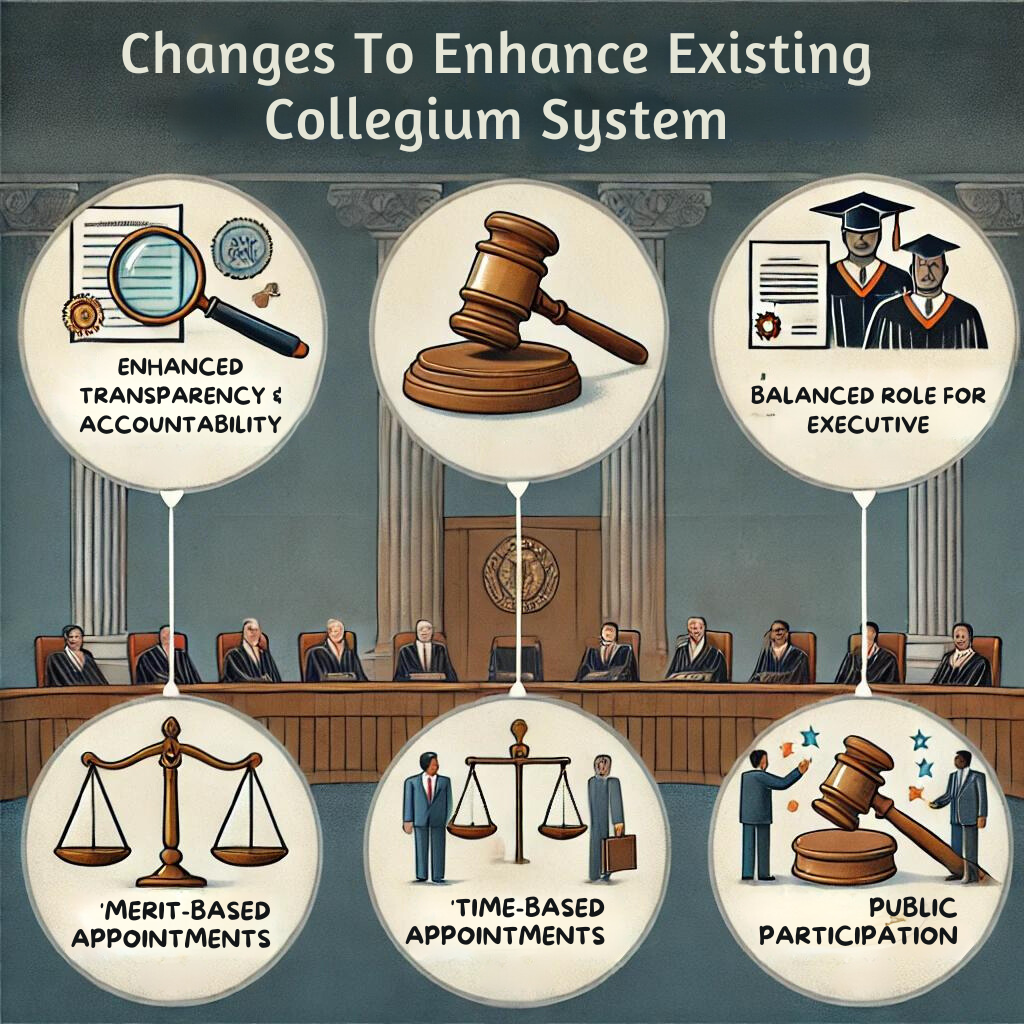The debate on judicial appointments in India, as guided by Articles 124(2) and 217(1) of the Constitution, points to many an imperfection with which the present system of collegiate functioning has to grapple. Though theoretically designed to safeguard judicial independence, the system has come under attack for its non-transparency and non-accountability and, worse still, for Nepotism. The National Judicial Appointments Commission was meant to remove these defects by taking along all stakeholders in the process, but it fell like a pack of cards before the Supreme Court in 2015.
The evolution of the collegium system, through what came to be known as the First, Second, and Third Judges Cases, meant that a set of senior judges would come together to make decisions on appointments. However, the growing opacity in its decision-making, lack of diversity, and complete absence of any external oversight attracted calls for reforms. The composition of NJAC brought together members from the judiciary, executive, and civil society, and such balancing ensures merit-based, transparent, and accountable judicial appointments.
| GS Paper | General Studies II |
| Topics for UPSC Prelims | Articles 124(2) and 217(1), National Judicial Appointments Commission, Supreme Court, First Judges Case, National Judicial Appointments Commission, Law Commission of India, Parliamentary Standing Committee, Judicial Appointment Mechanisms Across Different Countries. |
| Topics for UPSC Mains | Arguments in Favor and Against of the Collegium System in India. |
Origin of the Article
This editorial is based on “Reforming the process of judicial appointments,” published in The Hindu on 02/08/2024. The article discusses the transparency and accountability issues within India’s collegium system and the challenges in reforming it.
Relevancy for UPSC Students
For UPSC students, understanding this topic is crucial as it ties into GS Paper 2, covering the Separation of Powers, Judiciary, and Transparency & Accountability. It helps in comprehending the complexities of judicial reforms and the balance of power, which is essential for both Prelims and Mains exams.
Why in News
The ongoing debate over India’s judicial appointments system, particularly the collegium system, has again come to the fore due to transparency and accountability concerns. The dissolution of the National Judicial Appointments Commission (NJAC) in 2015 underscores the complexities of judicial reforms, a topic frequently addressed in UPSC examinations, such as the 2017 Mains question on the NJAC Act. Understanding this issue is crucial for aspirants, given its implications for judicial independence and governance.
How the Collegium System has Evolved?
The Collegium system in India has evolved significantly over the years through various landmark judgments. Initially, the executive had a prominent role in judicial appointments, but this shifted towards a more judiciary-centric approach with the establishment of the Collegium system, which emphasizes consultation and concurrence among the senior judges.
First Judges Case (1982)
In the S.P. Gupta vs. Union of India case, the Supreme Court ruled that “consultation” with the Chief Justice of India (CJI) did not mean “concurrence.” This decision gave the executive a larger role in judicial appointments, marking an era where the executive’s opinion was considered predominant.
Second Judges Case (1993)
The Supreme Court Advocates-on-Record Association vs. Union of India case overruled the First Judges Case. It established that the CJI’s role should be primary and interpreted “consultation” as “concurrence,” thus creating the Collegium system. This system prioritized the collective opinion of the CJI and senior judges.
Third Judges Case (1998)
This case reaffirmed the Collegium system when the Supreme Court, in response to a Presidential reference under Article 143, held that the CJI must consult with the four senior-most judges. This ruling solidified the Collegium system as the cornerstone of judicial appointments in India.
Memorandum of Procedure (MoP)
The MoP, created under the guidance of the Supreme Court, details the process for appointing judges. Drafted by the Ministry of Law and Justice, it aims to increase transparency and resolve deadlocks in the appointment process. Despite its intent, debates over its clauses have led to persistent deadlocks between the judiciary and the executive.
National Judicial Appointments Commission (NJAC)
The NJAC was introduced through the Ninety-ninth Constitutional Amendment in 2014, aiming to include multiple stakeholders in the judicial appointment process. It included the CJI, two senior judges, the Law Minister, and two eminent persons. However, it was struck down by the Supreme Court in 2015.
Fourth Judges Case (2015)
The Supreme Court, in a 4:1 verdict, declared the NJAC Act unconstitutional. The court emphasized that the NJAC compromised judicial independence by involving the executive, thus violating the basic structure of the Constitution. This ruling reinstated the Collegium system.
What are Arguments in Favor of Collegium System in India?
The Collegium system is often defended for its ability to uphold judicial independence and ensure merit-based appointments. It aims to insulate the judiciary from political pressures and promote diversity within the judicial ranks.
Upholding Judicial Independence
The Collegium system prevents political interference by ensuring that judges appoint their peers. This separation from the executive branch is crucial for maintaining the rule of law and delivering unbiased justice.
Prioritizing Merit and Experience
By focusing on qualifications, experience, and judicial acumen, the Collegium system ensures that the most competent individuals ascend to the judiciary. This merit-based approach enhances the quality and efficiency of the judicial system.
Promoting Diversity and Inclusivity
The Collegium system has facilitated the appointment of judges from diverse backgrounds, including women and marginalized communities. This inclusivity helps the judiciary reflect India’s societal diversity, fostering greater public trust.
Ensuring Institutional Memory and Continuity
Relying on senior judges for appointments preserves institutional memory and ensures continuity in judicial practices. This is vital for maintaining consistency in legal interpretations and precedents in a complex legal system like India’s.

What are Arguments Against Collegium System in India?
Critics argue that the Collegium system suffers from a lack of transparency and accountability, leading to potential nepotism and insufficient diversity within the judiciary.
Lack of Transparency
The Collegium system’s decision-making process is often opaque, with little public scrutiny. This secrecy can undermine public trust and raise questions about the fairness of judicial appointments.
Uncle Judges’ Syndrome
The system’s closed-door deliberations can foster an insular culture, potentially leading to nepotism and favoritism. Personal connections may sometimes overshadow merit, compromising the quality of judicial appointments.
Lack of Diversity and Representation
Despite its intentions, the Collegium system has struggled to adequately promote diversity in terms of gender, caste, and regional representation. This lack of diversity can result in a judiciary that does not fully reflect the Indian populace.
Lack of External Oversight and Input
The absence of external checks from the public, legal experts, or civil society organizations can insulate the decision-making process from broader societal perspectives. This lack of oversight may lead to biased or uninformed appointments.
How do Judicial Appointment Mechanisms Differ Across Countries?
Different countries employ varied mechanisms for judicial appointments, often involving multiple stakeholders to ensure a balanced and transparent process.
United States of America
In the U.S., federal judges are appointed by the President and confirmed by the Senate. This process includes an assessment by the American Bar Association and a review by the Senate Judiciary Committee. Judges hold lifetime tenure, contingent upon good behavior.
United Kingdom
The UK’s Judicial Appointments Commission, established in 2005, oversees the appointment of judges. This commission includes a diverse group of legal professionals and laypeople. The Lord Chancellor retains a residual power to reject candidates based on merit.
Other Countries
Countries like Canada and South Africa utilize independent Judicial Appointment Commissions, which include various stakeholders to ensure transparency and merit-based appointments. Similarly, Ireland, Israel, New Zealand, and the Netherlands have established judicial appointment committees.
PESTEL Analysis
| Political: The debate over the collegium system and the NJAC highlights political influences and the struggle between the judiciary and the executive for control over judicial appointments. This tug-of-war affects the balance between judicial independence and government oversight, underlining the need for a system that ensures both. Economic: While not directly impacted, the efficiency and transparency of the judicial system influence economic decisions, investor confidence, and overall economic stability in India. Delays and opacity in judicial appointments can lead to prolonged legal battles and uncertainty, which deter economic activity. Social: The lack of diversity within the judiciary, as criticized under the collegium system, points to a broader societal issue. An inclusive appointment process that reflects India’s diverse demographic can enhance the judiciary’s understanding and handling of social issues. Technological: There is minimal direct technological impact on the judicial appointment process. However, leveraging technology for transparency, such as livestreaming appointment proceedings or using digital platforms for public feedback, could be beneficial. Environmental: This factor is largely irrelevant to the judicial appointments themselves but could be considered in broader judicial policies and case laws that impact environmental regulations and corporate responsibility. Legal: The entire discussion around the NJAC and the collegium system is rooted in legal interpretations of the Constitution. Changes in these systems have deep legal implications regarding the separation of powers, the role of the judiciary, and constitutional mandates concerning judicial appointments. |
What Changes Could Enhance Existing Collegium System?
Reforms aimed at increasing transparency, accountability, and efficiency could significantly improve the Collegium system.
Enhanced Transparency and Accountability
Clear guidelines and public consultations should be incorporated into the judicial appointment process. This would increase transparency and ensure that the judiciary remains accountable to the public.
Balanced Role for the Executive
A revised NJAC model that includes representatives from the judiciary, executive, and civil society could balance judicial independence and accountability. This would help prevent the judiciary from becoming overly powerful.
Merit-Based Appointments
Strict adherence to merit-based criteria is essential. Emphasizing qualifications, experience, and judicial acumen would ensure that the most competent individuals are appointed, enhancing the judiciary’s overall effectiveness.
Time-Bound Appointments
Establishing strict timelines for the Collegium process would address delays in judicial appointments. This would help ensure that the judiciary remains fully staffed and capable of handling its caseload efficiently.
Public Participation
Incorporating public input through consultations, online forums, and feedback mechanisms would make the judicial appointment process more democratic and responsive to societal needs.

Conclusion
The debate over India’s judicial appointments highlights the need for reform in the collegium system to address issues of transparency, accountability, and delays. Revising the NJAC or adopting similar reforms could help resolve these challenges and improve the overall functioning of the judiciary. For UPSC aspirants, understanding this complex issue is crucial, as it underscores the ongoing evolution of India’s legal framework.
| UPSC Civil Services Examination, Previous Year Questions (PYQs) Mains Q. Resorting to ordinances has always raised concerns on violation of the spirit of separation of powers doctrine. While noting the rationales justifying the power to promulgate ordinances, analyze whether the decisions of the Supreme Court on the issue have further facilitated resorting to this power. Should the power to promulgate ordinances be repealed? (GS Paper II, 2015) Q. Compare and contrast the judicial appointment mechanisms in India with those in the UK, South Africa, and France. How can India learn from these systems to improve transparency and accountability in its judicial appointments? |


